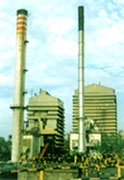BILT Ballarpur
 Two Leaves Company
Two Leaves Company
SCORE 33.44%
RANK THREE
Ballarpur Industries Ltd ( bilt ) operates an integrated pulp and paper mill on the banks of the Wardha river about two km from the town of Ballarshah in Chandrapur district of Maharashtra. It has to be noted that the Ballarpur unit is the only mill of the bilt group that figures high in the ratings.
The company has no exclusive environmental department at the corporate level, although it has one at the production unit level, which is clubbed with its research and development wing. The mill had drafted a corporate-level environmental policy statement in 1994. But the same has not been signed formally by the board of directors. The policy is general and does not take into account specific environmental aspects of the production unit. It ignores the long-term environmental sustainability of its raw material usage.
This becomes important as the mill procures its entire pulp requirement from natural forests allotted by the government. This dependence on bamboo and wood supplies is not only unsustainable in environmental terms but also makes bad business sense. The government supply distorts the market and worse it is a major cause for deforest-ation. The company has not given data on the price it is getting government forest produce. bilt Ballarpur should try to move towards social/farm forestry.
So, how did the company rank high in the ratings despite the fact that its fibre-sourcing policies are rated poor? Because it scores quite high on two grounds: efficiency in production and reuse and recycling of wastes. bilt -Ballarpur's fibre-use efficiency stands at 49 per cent, which is quite close to the maximum of 52.5 per cent according to the rating criteria. And this efficiency is increasing consistently. But its energy consumption per tonne of paper produced is quite high at 48.7 giga joules and approaches the high of 50 giga joules reserved for the worst performers. Per unit water consumption is also quite high, though at 193 tonnes, it is under the maximum of 250 tonnes. The achievable target is 60 tonnes of water for each tonne of paper.
The company's water conservation initiatives are above average. The company's thrust has been on selection of appropriate technology and equipment with a view to achieve pollution abatement and loss prevention. In its mission statement, bilt states that loss prevention is one of the major steps towards pollution abatement. The mill also has good systems of re-covering chemicals from effluents, and it is also making efforts to shift towards elemental chlorine-free bleaching.
The local community and the media were severely critical of the mill's environmental performance. Lime sludge is disposed of three km away from the plant in a sludge garden that resembles a huge, snow-clad mountain. The lime blows with the wind, causing a burning sensation in the eyes of residents of nearby areas. Although there are some encouraging signs, the company has a lot to do to improve its image.
And for the sake of our forests, its fibre sourcing needs some serious rethinking.
| PARAMETERS | WEIGHTED SCORE | WEIGHTED TOTAL |
| Corporate policy and management system | 10.75 | 35 |
| Input management | 0.69 | 8 |
| Process management | 10.04 | 21 |
| Recycling and reuse | 4.9 | 10 |
| Waste management and pollution controle | 1.56 | 10 |
| Compliance and community perception | 4.5 | 14.5 |
| Total | 32.73 | 98.5 |
